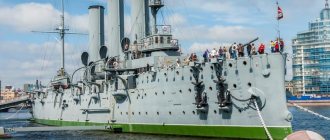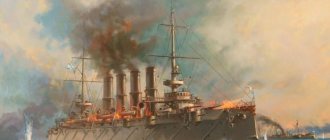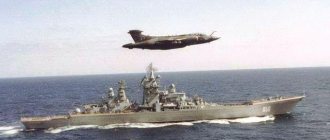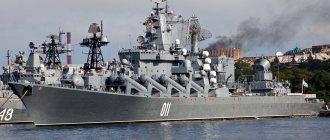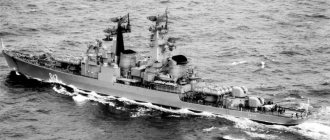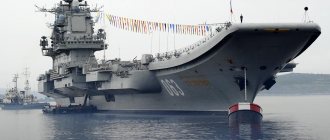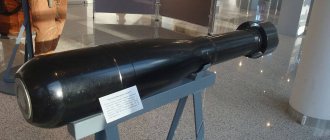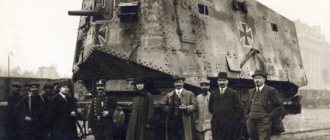Historical reference
The history of the cruiser "Varyag" and its creation began in 1898. In 1900 it was transferred to the Russian Empire. The technical characteristics of the Varyag were at their best and replicated the best modern formats of that time:
- Powerful weapons: cannons and torpedoes.
- The latest steam boilers.
- Electricity.
- Telephones and radio stations.
In 1901, the Varyag passed successful tests and was sent to Port Arthur, where it anchored at the end of the winter of 1902. Already at that time, Captain Rudnev noted that the ship had a weak repair base and an unsuccessful boiler design.
Because of this, after just a few years of service, the Varyag was unable to reach a speed of more than 14 knots (about 26 km/h). Such a low speed negated all its advantages, and the question of repair was raised. However, during the tests the cruiser reached the required speed and the issue was resolved.
Interesting fact: the boilers served well on other battleships for many years, and their use did not raise any complaints. Many errors were found in the reports of commander Rudnev, but it is not possible to find out the truth today.
Improvements during service
Throughout its life, the Varyag underwent major modernization twice. The first was produced by the Japanese, who raised the cruiser in 1905. During the repairs, the chart room, pipes, fans, navigation bridges were changed, mine net poles and top platforms were removed. The 75mm guns were replaced with 76mm Armstrong guns.
After the return of the Russian ship in 1916, the bow and stern main caliber guns were moved to the center plane, resulting in an increase in the power of the broadside salvo.
The machine guns were converted to fire at air targets. Dead moves have been eliminated in the mechanics. And most importantly, the artillery received partial armor protection (shortened shields) - conclusions were drawn from the past.
The only fight
At the end of 1903, the Varyag was transported to the neutral port of Chemulpo (Korea) . Here a “parking lot” was formed for several ships of other states. At the beginning of 1904, the gunboat "Koreets" arrived at the roadstead.
On February 8, 1904, a Japanese squadron of 6 armored cruisers and 8 destroyers blocked the port. The Korean's attempt to swim was unsuccessful: he was attacked and returned.
On the morning of February 9, Rudnev received an ultimatum from the commander of the Japanese squadron: leave the port before noon, otherwise the Japanese would attack. This allowed Japan to use the port as a supply base and the first trophy, and also eliminated the threat from the sea.
It was decided to try to get to Port Arthur, and if that didn’t work, destroy the “Varyag” and “Korean”. At noon, both ships left the port and ran into Japanese ships.
The battle of the cruiser “Varyag” began, which lasted only an hour. During the battle, “Varyag” suffered significant losses in equipment and people. At an officers' meeting, it was decided to evacuate the crew and scuttle the ship to avoid capture. In the evening, “Varyag” and “Sungari” were flooded, “Korean” was blown up.
This day became the date of the beginning of the Russo-Japanese War.
The fate of the sailors
All sailors were picked up by foreign ships and delivered to Russia through neutral waters. From March 19 to April 6, 1904, all sailors were transported in groups to Odessa. From there the sailors went to St. Petersburg. They were given a warm welcome in the cities they passed through.
On April 16, the sailors arrived in the capital at the Nikolaevsky station. A gala dinner was given to the heroes in the Winter Palace, which was attended by Emperor Nicholas II. Nicholas II presented each guest with a personalized watch and the St. George Cross. This was the first time in the history of Russia when absolutely all participants in the battle received an award.
The Varyag crew was disbanded, the sailors were transferred to other ships, and the commander of the Varyag cruiser was promoted and retired.
Japan also awarded Rudnev the Order of the Rising Sun for his courage, and a museum in memory of the heroes was established in Seoul.
Naval dynasty
The commander of the Varyag, Vsevolod Rudnev, had only one real battle, in which he was defeated. But the Japanese who won that battle admired the courage of the Russian captain and his crew...
Once upon a time, the ancestor of the Varyag commander, sailor Semyon Rudnev , received the rank of officer for his bravery in the battle of Azov. Thus began the Rudnev maritime dynasty, each representative of which was ready to sacrifice everything in the name of the Motherland.
Vsevolod was born on August 31, 1855 in the fortified city of Dynamünde, where his father, captain 2nd rank Fyodor Nikolaevich Rudnev , commanded the fire guard. Fyodor Nikolaevich fought with the Turks in the Black and Mediterranean Seas, on the Adriatic. He retired in 1857, already with the rank of captain 1st rank. He was not destined to see his son continue the dynasty - Fyodor Rudnev died when Vsevolod was barely 9 years old. But the boy always dreamed of the sea.
His father’s merits helped him in 1872, when, after graduating from high school, Vsevolod decided to enter the Naval School. The training was paid, but as a representative of a naval dynasty, the state paid for him.
Armored cruiser "Varyag". Infographics Read more
Technical and human losses
According to the report from the Russian side, “Varyag” fired more than 1.1 thousand shells, “Koreets” - more than 50 and a smoke screen. However, these data are questioned: according to calculations of the remaining shells, much fewer were fired.
The report also contains information about losses from the enemy:
- 1 destroyer sunk.
- 3 cruisers were damaged, one of them sank.
- 30 people were killed.
However, Japanese sources do not confirm any losses on their part. There is no information even about shells hitting ships.
But much more is known about losses on the Russian side. “Varyag” was badly damaged: the guns were broken, 4 large holes were made by fire and many small, insignificant ones. All this was restored after the cruiser was raised.
There were many casualties among the sailors:
- Officer Nirod and 38 sailors were killed.
- 3 officers and 70 lower ranks were wounded.
- Commander Rudnev was wounded in the head and shell-shocked.
After the landing, 24 people remained under treatment, two of them died later. 11 people were transferred for treatment to other ships.
Cruiser design
"Varyag" was created as a ship superior in its combat qualities to "Diana" or "Aurora", which were actually already outdated by the beginning of the Russo-Japanese War.
Sketch of two main projections of the cruiser "Varyag"
Indeed, the project of the new cruiser turned out to be quite advanced for the beginning of the 20th century. Unfortunately, at the same time, a number of miscalculations were made during the construction of the ship, which sharply reduced its real combat effectiveness.
Frame
The “backbone” of the cruiser was the keel, which connected the bow and stern stems (massive bars cast from bronze) and consisted of steel profiles and sheets. The so-called floras (transverse sheets forming the frame of the lower part of the ship) were attached directly to it. A second bottom was laid on top of the resulting structure, which extended the entire length of the hull and served as a good support for the power plant and various mechanisms.
The second “roof” of the hull was formed by a massive armored deck, which simultaneously served as the main element of protecting the ship from enemy artillery fire. In the bow of the cruiser there was an elevation (forecastle). Thanks to this, the Varyag could successfully overcome large waves formed during a storm and not lose longitudinal stability. The total height of the hull reached 10.46 meters with a design weight of 2,900 tons.
Armored deck
Protection of the interior of the cruiser was provided by interconnected armor plates with thicknesses of 38.1 and 19 mm, forming a single armored deck, which, because of its configuration, was called “carapace” (that is, turtle-like). It covered the ship not only from above, but also along the sides, dropping 1.1 meters below the waterline. The elevation of the armored deck above the engine room was 7.1 m, and above the main line of the hull - 6.48 m.
The sides of the Varyag were additionally protected by so-called cofferdams - waterproof compartments between the armored deck and the outer skin. Coal pits were adjacent to them on the inside.
Loading coal onto the cruiser "Varyag"
Thus, the damage received when a shell hit the side could be localized without fatal consequences for the ship - even penetration of the armor itself did not lead to damage to vital mechanisms. The rubber dams had no internal contents, although at first they wanted to fill them with cellulose.
Powerplant and propellers
The cruiser "Varyag" was driven by steam engines, the maximum power of which was 20 thousand horsepower, but due to a number of technical reasons this value was never achieved in practice. The operation of the power plant was ensured by thirty Nikloss boilers located in three compartments: 10 in the bow, 12 in the stern and 8 in the middle.
It should be noted that in the last years of the 19th century, Nikloss boilers were a novelty, differing from previously used and similar devices, first of all, in their relatively low weight. The initiator of equipping the Varyag with such boilers was Charles Crump. In the future, this decision turned out to have quite unpleasant consequences, causing numerous breakdowns.
Two three-blade propellers with a pitch of 5.6 meters were used as propulsion devices for the ship. For the initial rotation of the shafts to which they were connected, the cruiser had a kind of “starters” - auxiliary two-cylinder steam engines.
Electrical equipment
A significant part of the mechanisms of the cruiser "Varyag" was equipped with electric drives. In addition, there was a lighting system, a desalination plant and other equipment on board, which also required electricity. The total consumption was more than 400 kilowatts - a lot for a ship of this size at that time.
Nikloss boiler diagram
Energy generation was carried out by three dynamos. One of them was on the living deck, and the other two were on the bow and stern. If they failed, power could be provided according to an emergency circuit, from sixty batteries placed in a special compartment.
The list of main consumers of electricity is as follows:
- Fans (boiler rooms, machine and general ship fans). During operation, up to 119.2 kW was used;
- Lighting. A total of 700 lamps, in nominal mode half of them were turned on, consuming 22.4 kW;
- Gun elevators. Consumed up to 33.3 kW at half load;
- Sump pumps. There were six of them, but usually only one was connected, consuming 40 kW;
- Spotlights. Required 54 kW;
- Winches (boat, garbage and for lifting anchors). Consumed a total of 136.1 kW.
In addition, electricity was used in the galley to operate dough mixers and for other purposes.
Ventilation system
The ventilation on the cruiser "Varyag" was quite powerful and well developed. Particular attention was paid to the engine rooms - the air in them was completely renewed twenty times within an hour. True, when moving at full speed, the temperature inside these rooms still reached forty-three degrees or even more.
In the artillery cellars, an hourly twelve-fold air renewal was provided, and in the remaining internal rooms located under the armor - five-fold. The room allocated for the bow dynamo was the worst ventilated, which is why the temperature inside it often reached 55 degrees.
Life support systems
The cruiser's crew was located mainly on the living deck and partly in the bow, directly under the forecastle.
Cabins
The “lower ranks” were provided with hanging bunks, which were removed during the day, and lockers. The sailors used folding tables for meals.
The best conditions were created for the ship's commander. The premises allocated for it occupied the aft part of the living deck, which extended 12 meters in length. The cabins for officers were single, their area was six square meters. The conductors were accommodated in double cabins. The chief navigator, senior mechanical engineer and senior officer were in slightly better conditions - their cabins had an area of 10 sq.m.
In addition, on the living deck there was an infirmary with a separate operating room, a pharmacy, a bathhouse and a ship's church. There were also two wardrooms - for officers and conductors.
Further fate
At the beginning of August 1905, Japan raised the Varyag from under the water, and a few days later the ship was included in the Imperial Navy with a reduction in rank. The repairs took almost 2 years, and in early July 1907 the cruiser was commissioned as Soya. For the next 7 years it was used for educational purposes.
It is noteworthy that the Japanese highly appreciated the feat and courage of the Russian sailors of the Varyag: the previous name was left on the stern, and the recruits were told without fail about the legendary Russian ship, the heroic warriors of which went into battle against an entire trestle and chose to sink the ship so as not to give up his enemy and not surrender.
During the First World War, when peace was established between the countries, Soya was bought out. It was sent to Vladivostok, where it was again renamed “Varyag”. The cruiser made the transition to Romanov-on-Murman.
In February 1917, the Varyag was transported to England for repairs. It was soon confiscated because the Soviet government refused to pay its debt to the Russian Empire. After 3 years, it was sold to Germany for scrap metal, but in 1925, while being towed, the ship was caught in a storm and sank in the Irish Sea, not far from the coast.
Local residents removed some metal parts and took them away. The remains were blown up.
Feat today
In 2003, an expedition led by Denisov found out the exact location of the ship's sinking. In the same year, an attempt was made to raise the ship. Rudnev’s grandson, who lives in France, took part in it. We managed to get some small parts.
In mid-2009, after 6 years of negotiations with the Korean side, Russia received a 9-month lease for some relics associated with the Varyag and the Korean. Until this moment, the exhibits were in the museum of the city of Incheon, in Russia the exhibition was opened in the Hermitage (St. Petersburg), then it was repeated in Moscow and large cities.
At the end of 2010, the mayor of Incheon handed over the Varyag gyus (nose flag) to the Russian Federation for storage for 2 years. Afterwards the shelf life was increased by 10 years.
Exemplary career
Rudnev justified his trust by graduating from college with honors and being awarded the Nakhimov Prize. The promising graduate was sent to the training ship Petropavlovsk.
By 1880, he had risen to the rank of midshipman and served on the cruiser Africa. On this ship, Rudnev went on a trip around the world. Subsequently, he wrote a book about his first circumnavigation of the world.
In 1888, the Russian fleet received the first steam military transport, the Peter the Great. Rudnev was assigned to lead the new ship from France to Kronstadt, and he coped with the task “excellently.” The same year the officer got married. His chosen one was Maria Shwan , the daughter of the hero of the Sevastopol defense Nikolai Karlovich Shwan .
Rudnev always served conscientiously, was not known for his temper, and did not enter into disputes with his superiors, even if certain orders raised doubts in him.
In 1893, Rudnev received the rank of captain of the 2nd rank and became the senior officer of the squadron battleship Emperor Nicholas I. He sailed on it for about a year in the Mediterranean as part of the Russian squadron. Then there was another trip around the world. Returning to Kronstadt, Rudnev was appointed commander of the coastal defense battleship Admiral Greig, and then commander of the destroyer Vyborg.
Vsevolod Fedorovich Rudnev. Photo: Commons.wikimedia.org
Memory in culture
Despite the short service and only one battle, the Varyag’s feat remained in the memory of the people and government. In 1954, on the occasion of the 50th anniversary of the feat, veteran sailors of the cruiser were awarded stars and medals “For Courage”. In the same year, the Project 68-bis artillery cruiser under construction was named “Varyag”, but under Khrushchev the unfinished ship was dismantled.
In 1965, the Project 58 missile cruiser, which received the same name, joined the Pacific Fleet. He served until 1990.
In addition, the memory of the cruiser is briefly immortalized as follows:
- Monument to fallen sailors at the Marine Cemetery in Vladivostok and the Street of Heroes "Varyag".
- Monuments to Rudnev in Tula and Novomoskovsk and the museum of his biography in the village of Savino (Tula region).
- Memorial plaque and monument (author - Russian sculptor Balashov) in the port of Incheon (South Korea).
- Commemorative plaque and monument in the Firth of Clyde (Scotland), where the cruiser sank.
- In several cities of Russia and Ukraine there are memorial plaques in honor of specific individuals: gunner Zinoviev, second lieutenant Poglazov, fireman Mikhailov and others.
- The Naval Museum (St. Petersburg) has an exhibition dedicated to the Varyag.
In addition, the feat of sailors is told in several literary works (Andreev’s “Breakthrough”), in musical works (a striking example: the song “Our proud “Varyag” does not surrender to the enemy”) and in films (the feature film “Cruiser “Varyag” and the documentary of the same name two-part film from 2004). Stamps and postcards featuring the aircraft carrier were also issued.
The Varyag's feat in the Russo-Japanese War remained for a long time an example of the courage and honor of sailors. Having lost in an unequal battle and not wanting to surrender, the commander decided to sink the ship, and the sailors supported him. The short but dramatic battle is still remembered: expeditions are organized to the site of the sunken cruiser and works of art are created.
Admiral's family
In 1916, Maria Nikolaevna , Rudnev's widow, sold her estate in Venevsky district and moved to Tula with her two youngest children. In 1917, their eldest son and his wife came to visit them. When the revolution began, the family moved to their relatives in Sevastopol, and then emigrated first to Yugoslavia, then to France.
Panteleimon , Rudnev's youngest son, lived in France after emigrating and worked as a theater artist. And even as a tourist he came in 1969 to the USSR and to his father’s homeland, Tula. The middle son, George , became one of the leaders of the automobile industry in France. But in 1946 he came as a tourist to Venezuela and stayed there forever. The grandson of the rear admiral and the son of George, also George, was born in Paris in 1940, and came to Venezuela at the age of six. In 1995, he came to Russia and visited his grandfather’s grave in the village of Savino. He says that he brought earth from the grave, which became the most expensive relic in his house. In his new homeland in the capital of Venezuela, Caracas, Georgy Rudnev was the headman of an Orthodox church.
Rudnev's eldest son Nikolai Vsevolodovich worked as an agronomist in France. After World War II he returned with his family to his homeland.
Nikolai Vsevolodovich moved to Tula in 1958, where he died in 1963, having managed to publish a book about his father, “Commander of the Legendary Cruiser,” in 1960 at the Prioksky Publishing House. Despite a solid circulation of 50,000 copies, it has long become a bibliographic rarity. Nikolai Vsevolodovich also donated a significant part of his father’s personal belongings to the regional museum of local lore, which are now exhibited in the V. F. Rudnev Museum in the village of Savino.


